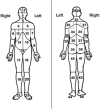Pain measurement in the National Social Life, Health, and Aging Project: presence, intensity, and location
- PMID: 25360020
- PMCID: PMC4303094
- DOI: 10.1093/geronb/gbu101
Pain measurement in the National Social Life, Health, and Aging Project: presence, intensity, and location
Abstract
Objectives: To describe the rationale for the pain presence, location, and intensity measures in the National Social Life, Health and Aging Project (NSHAP).
Method: Responses to the pain presence, location (pain map), and intensity (verbal descriptor scale) items were analyzed by gender and age (62-69, 70-79, and 80-91). Pain intensity was dichotomized (none to mild vs moderate or higher) and compared by demographics, physical function, mood, and self-rated health. All analyses used Wald tests to compare sample means.
Results: Participants completed the pain presence (n = 2,430/2,799), location (n = 2,558/2,799), and intensity (n = 2,589/2,799) items. Pain items varied by gender with women reporting more head, arm, hip/buttock, leg, and foot pain compared to men, (p < .05) at each individual site. Women also reported more intense pain compared to men-2.13 versus 1.94, respectively (p < .05). Pain items demonstrated remarkable similarity among age cohorts. Health indicators were significant and in the expected direction (p < .001). An increase in comorbidity, ADL and IADL dependence, worse self-rated health, and more depressive symptoms were each significantly more common among participants who reported moderate or greater pain compared to none to mild pain.
Discussion: Pain presence, location, and intensity measures were successfully integrated into NSHAP Wave 2 and exhibit construct and external validity.
Keywords: Location; Measurement; Older adult; Pain..
© The Author 2014. Published by Oxford University Press on behalf of The Gerontological Society of America. All rights reserved. For permissions, please e-mail: journals.permissions@oup.com.
Figures
References
-
- AGS Panel on Persistent Pain in Older Persons. (2002). The management of persistent pain in older persons. Journal of the American Geriatrics Society, 50, S205–S224. - PubMed
-
- Atkinson T. M., Rosenfeld B. D., Sit L., Mendoza T. R., Fruscione M., Lavene D, … Basch E. (2011). Using confirmatory factor analysis to evaluate construct validity of the Brief Pain Inventory (BPI). Journal of Pain and Symptom Management, 41, 558–565. 10.1016/j.jpainsymman.2010.05.008 - PMC - PubMed
-
- Blyth F. M., Rochat S., Cumming R. G., Creasey H., Handelsman D. J., Le Couteur D. G, … Waite L. M. (2008). Pain, frailty and comorbidity on older men: The CHAMP study. Pain, 140, 224–230. 10.1016/j.pain.2008.08.011 - PubMed
-
- Caraceni A., Cherny N., Fainsinger R., Kaasa S., Poulain P., Radbruch L., De Conno F. (2002). Pain measurement tools and methods in clinical research in palliative care: Recommendations of an Expert Working Group of the European Association of Palliative Care. Journal of Pain and Symptom Management, 23, 239–255. 10.1016/S0885-3924(01)00409-2 - PubMed
Publication types
MeSH terms
Grants and funding
LinkOut - more resources
Full Text Sources
Other Literature Sources
Medical



